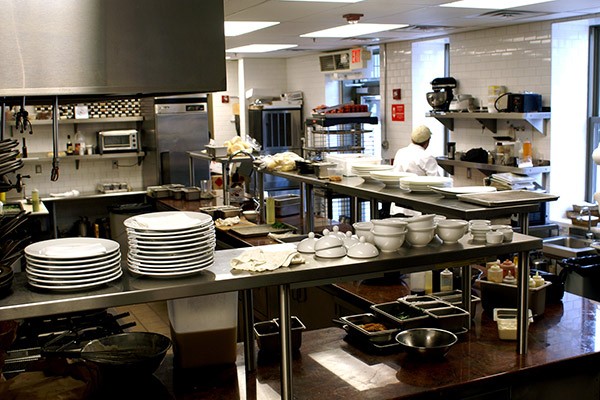360 Degrees of Restaurant Food Safety

Today's consumers demand fresh, locally sourced food and that means ingredients are now more susceptible to food safety issues than at any point in recent history. Here are some recent lowlights:
- Recent (massive) romaine lettuce E. coli outbreak - and subsequent product recall
- Tainted produce in McDonald's salads which recently sickened hundreds of consumers
- Bacteria in pre-cut fruit - the list goes on and on.
Based on these recent incidents, many consumers are afraid to eat a salad. In addition to the McSicknesses and widespread produce outbreaks, multiple restaurants have been in the news for foodborne illness outbreaks this summer. For instance, Chipotle is in the hot seat again, after nearly 700 guests became sick after eating at an Ohio location. While this isn't Chipotle's first foodborne illness crisis, they're not the only restaurant chain at risk. In fact, every restaurant is just one error away from a foodborne illness crisis.
What if an undertrained team member fails to thoroughly cook the chicken, wash his hands, or check the walk-in temperature? What if an employee comes to work while ill and infects guests with the highly contagious norovirus? Which company will be the next to make headlines for sickening (or even killing) its customers?
A number of problems can lead to foodborne safety issues, including:
- Undertrained employees who don't understand the importance of food safety and/or why food safety protocols are in place. They may take shortcuts, skip important safety procedures, or not wash their hands regularly. They might work when ill or not take the temperature of the burgers they're cooking. Any human error can cause a foodborne illness incident or outbreak.
- Antiquated paper and pen record-keeping that's difficult to analyze. There's no accountability when using paper checklists, so employees could say they completed their safety checks, but there's no way to know if they did it thoroughly and accurately - or at all.
- Cumbersome processes (such as lengthy checklists) that are time and labor intensive, as well as boring and tedious, so employees often skip it (or lie about completing it).
- "Pencil whipping" or cheating on inspections, audits and other safety standards (which is, sadly, commonplace in the industry). As much as we'd like to believe otherwise, many food service employees take shortcuts that put our foods - and customers - at risk. A big factor in pencil whipping is the monotony of the tasks. Many workers simply don't want to go through the same lengthy, repetitive processes day after day.
- Infrequent audits from third-party experts. Some restaurants have outside inspectors come just once or twice a year, which is not enough to ensure that all safety protocols are being followed. Regular checks from an objective expert can help ensure that a facility is operating safely. Equally important, an outside auditor can spot potential problems before they become true liabilities.
Let's stop pretending that "the way we've always done things" works. Instead, adopt a new 360 degree food safety solution. This approach would combine:
- Streamlined, digital checklists. Multiple employees per shift would answer a few, short, carefully curated questions each day. Fewer questions for more team members generate less "pencil whipping" and more accurate data. These checklists can be as short as a few (targeted, strategic) questions that take employees just a few minutes to complete. When the task is made easier (and shorter), employees are more likely to comply.
- Data-driven insights. By maintaining digital records, operators will have the data on what tasks are driving margin improvement. Paper records make it impossible to integrate and analyze critical data. By transitioning to digital systems - which is easy and affordable to do - restaurants and other food companies will have access to important information that can help elevate their businesses.
- Third party experts. Historically, the word "compliance" has signaled "CYA". It's less about excellence and safety, and more about legal protection. Regular, comprehensive third party training, inspections and audits can significantly improve food safety protocols and lower risks. And this means more frequently than just once or twice a year - consistency is key.
My colleagues and I spend significant time engaging in a dialogue about the 360 degree approach and how to overcome food safety challenges in an industry running towards a fresher food future. As part of this discussion, we're urging CEOs, VP of Operations, managers, and food safety directors to reevaluate and reinvent their procedures for a fresh food era, by migrating to 360 degree food safety solutions.
Migrating data from paper systems to digital makes it easier to store, access and analyze critical information, and gain a valuable 360 degree perspective, which is critical to keeping foods safer and food businesses more profitable. This is an important (and manageable) first step in helping the food service industry keep more accurate records of the foods that are grown, manufactured, sold, and served. It's important to note: these digital solutions are user-friendly, easy to implement, affordable, attainable and will result in measurable improvements.
Aaron Cohen co-founded CoInspect to make food safer and filing cabinets obsolete. CoInspect software powers food safety, quality assurance, and standards management for restaurants and food manufacturers. The company's obsession: Make software that is fast, flexible, and easy-to-use. For more information, visit www.coinspectapp.com or reach him at aaron@coinspectapp.com.


